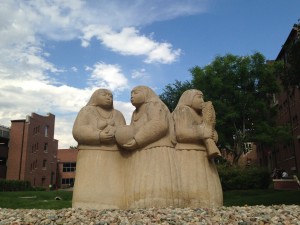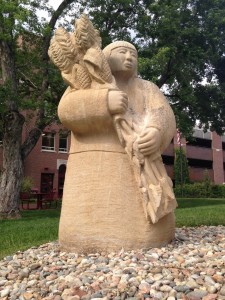
In April 2015, DU welcomed a new art installation to campus. Unlike the peculiar geometric statue outside Anderson Academic Commons or the talking lips outside the Ritchie Center, this installation seems to have a clear impression. “Harvest on the Rio Grande”, sculpted by Doug Hyde in 1983 and relocated from Summit County, depicts several Native American women gathering fruits and vegetables, walking toward each other. It was Hyde’s first monumental work, which he describes as representing Native communal and family values — appropriate for its location next to the Graduate School of Social Work.
There is one woman in this set of statues that caught my eye, as she is carrying several stalks of corn. Immediately, I recalled the stories of Thanksgiving — corn, being native to North America, was brought to Europe within the first few voyages of explorers. However, the history of corn extends beyond the initial years of European exploration. It was one of the first crops that humans domesticated 9,000 years ago in the transition from hunter-gatherer culture to agricultural-based society. It gained popularity to become a staple product for Native American civilizations. Eventually, it became a source for agricultural success in North America, encouraging growth across the continent. It was this success that Europeans eventually saw when first traveling to the “New World” and sought to replicate in Europe, causing its transfer in the infamous Columbian exchange.

Clearly, corn has a fair amount of historical importance. But what about its current role in society? As a matter of fact, corn is just as important today. It is the largest crop grown in the United States, according to the Journal of Agricultural and Food Information in 2008. Corn is used for food, seed, processed products and even fuel today. It also provides the ubiquitous high fructose corn syrup that is commonly used in many of our foods.
In fact, the United States’ need for corn has influence in the entire global agricultural system. While Western countries pushed developing countries to open markets through the IMF and World Bank, the United States maintained its heavy domestic subsidies on its own grains, especially corn. As a result, the United States surplus of corn was oftentimes dumped on developing countries, causing suffering within their own agricultural industries. This can be seen in the case of Mexico. The irony sets in as Mexico is believed to be the birthplace of modern corn. Similar to Blucifer, which links to the use of horses to destroy civilizations the ground where horses first evolved, “Harvest on the Rio Grande” shows the damage that modern society can wreak upon the birthplaces of modern goods and tools.

Furthermore, the United States’ production of corn can have quite an impact on the environment. Specifically, corn ethanol production, which is oftentimes believed to be a “clean” fuel, can create more carbon dioxide emissions than traditional gasoline, due to emissions and land changes in production. Corn, then, has fulfilled the potential to have an impact on both industry and global natural systems. It is a native North American product with a truly worldwide influence.
A glance at “Harvest on the Rio Grande” can be a glance at traditional Native American values, especially in its representation of corn as one of the first harvest goods in the world and traditionally North American. It represents the development of North American society before the arrival of Europeans. However, a closer look can also reveal the more harmful side of the American agricultural system. Without a doubt, corn is an essential product, historically and today, but some of its disservices signal that the use of corn should be re-evaluated. Maybe this new installation will remind students to keep community values in mind and even re-think what effects our American systems may have on the rest of the world. Either way, it’s important to consider a new perspective, even if it’s through our purple-hued glasses.

